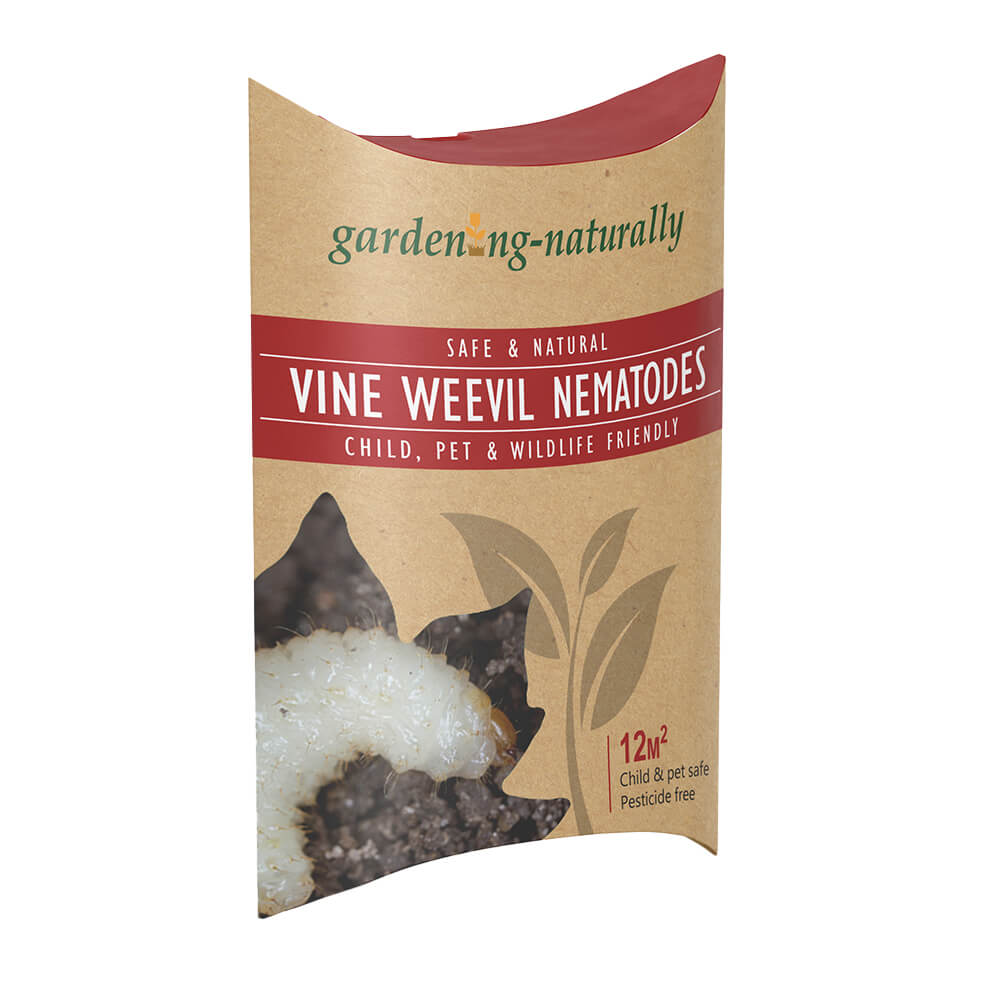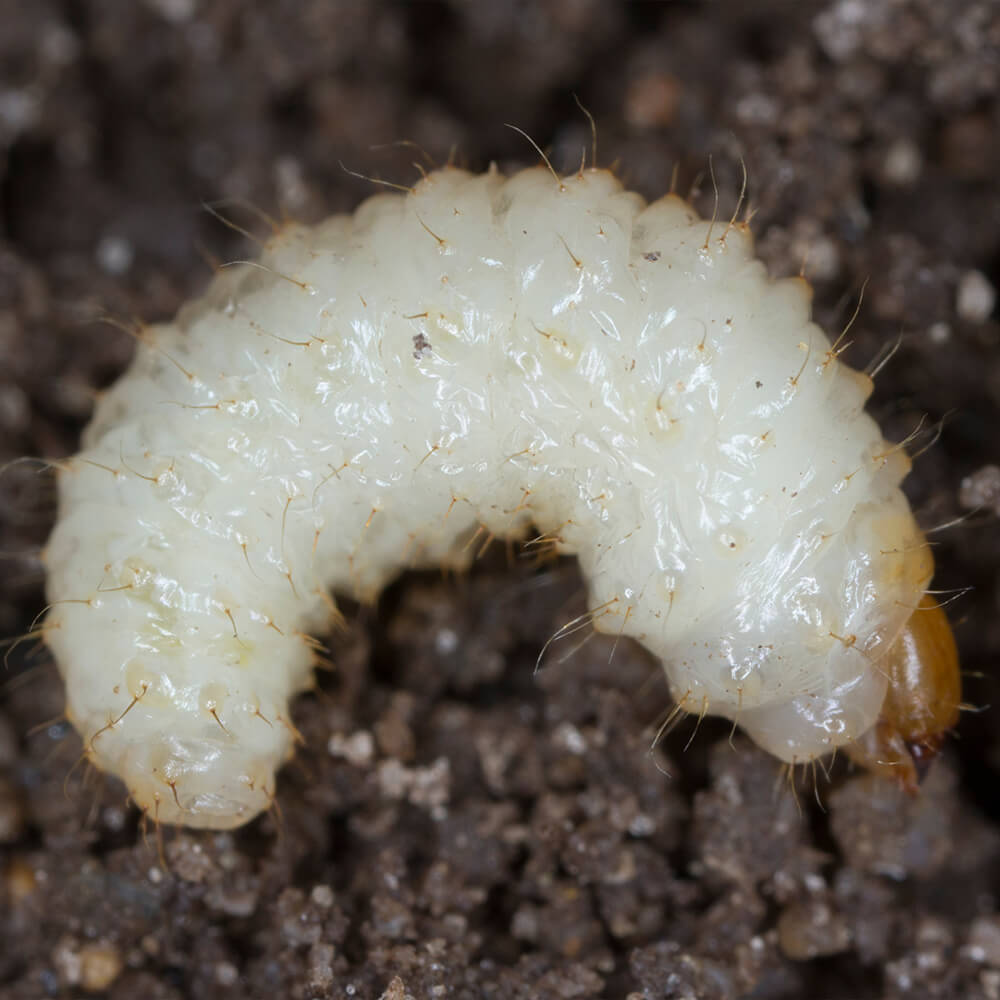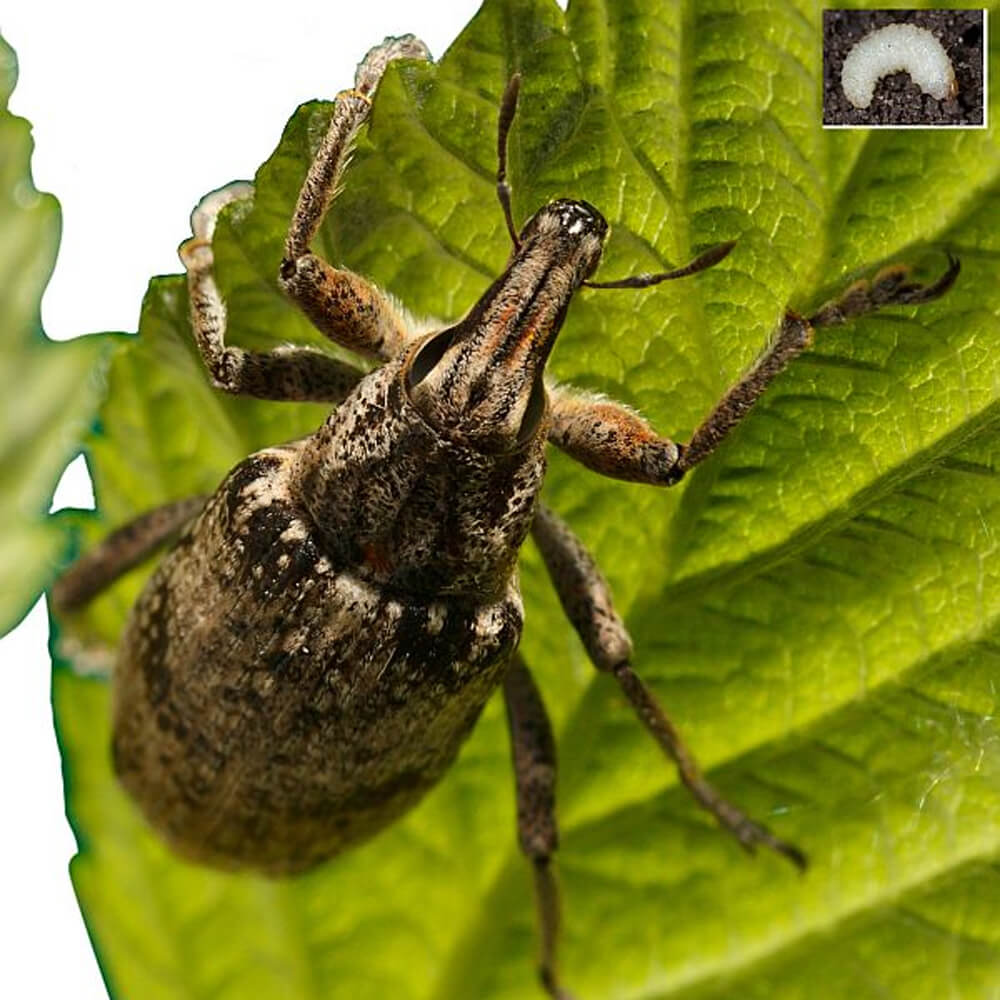Vine Weevil Nematodes 12sq.m Gardening Naturally
Vine Weevil Nematodes 12sq.m Gardening Naturally is backordered and will ship as soon as it is back in stock.
Vine weevil larvae are among the most destructive garden pests for container plants, ornamentals, fruit crops and greenhouse collections. Because they feed on roots beneath the soil surface, infestations often go unnoticed until serious damage has occurred.
What Are Vine Weevil Larvae?
Vine weevil larvae are the juvenile stage of the black vine weevil (Otiorhynchus sulcatus). They are creamy-white, C-shaped grubs with brown heads and no legs, usually measuring 5–10 mm. They live hidden in compost or soil where they feed on roots, crowns and tubers.
Damage Caused by Vine Weevil Larvae
Larvae cause far more damage than adult vine weevils. Plants may wilt despite moist soil, show yellowing leaves or collapse completely. When lifted from the pot, roots may be missing or heavily eaten. Strawberries, heucheras, fuchsias, cyclamen and many container-grown shrubs are particularly vulnerable.
Vine Weevil Life Cycle
Adults feed on leaves during spring and summer, creating notched edges. They lay eggs in soil during late summer and early autumn, which hatch into larvae. These larvae feed throughout autumn, winter and early spring, often killing plants before growth restarts.
Natural Vine Weevil Control with Nematodes
Our vine weevil nematodes contain Heterorhabditis bacteriophora, a natural biological control that targets the damaging vine weevil larvae in the soil. Adult vine weevils feed on leaves, but it is the larvae that cause the most harm by eating plant roots. These microscopic nematodes actively search for larvae, penetrate them and multiply inside, stopping the pest before it destroys your plants.
How Vine Weevil Nematodes Work
Once applied to the soil, the nematodes move through the root zone in search of larvae. When they find a host, they enter the body and prevent it from feeding further. As they reproduce, they continue spreading through the soil, providing long-lasting protection.
When to Apply Vine Weevil Nematodes
Larvae are most active in late spring and early autumn, making March to May and August to October the best treatment times. Nematodes work when soil temperatures remain above 12 ºC. In pots, greenhouses or other covered areas, you can use them at any time of year provided the soil is warm enough.
How to Apply Vine Weevil Nematodes
The nematodes come with instructions but they are mixed with water and applied directly around the roots where the larvae feed. Ensure the soil is moist before and after application to help the nematodes move through the soil. They can be applied to pots, containers and open ground. Repeat during the recommended treatment windows for continued protection.
The nematodes come with full instructions and can be applied using a watering can or a nematode applicator. Apply only when soil temperatures are consistently above 12 ºC.
Available Pack Sizes
Packs are available to treat 12 sq.m or 100 sq.m. One pack treats 12 sq.m.
Please note: Nematodes are a live product and cannot be returned. They usually have an expiry date of around two weeks.
Frequently Asked Questions
How do I know if I have vine weevil larvae?
Plants may wilt or collapse suddenly, or roots may appear eaten when repotting. These are clear signs of larvae feeding below the surface.
Are vine weevil nematodes safe around edible plants?
Yes. They are completely safe to use around fruit and vegetables with no waiting time before harvesting.
Can I use nematodes in containers?
Absolutely. Pots and containers are common hotspots for vine weevil, and nematodes are highly effective in these environments.
How long does treatment last?
A single application stays active for several weeks. Treat again in spring and autumn for year-round protection.
Do I need to control adult vine weevils too?
Adults cause mainly cosmetic damage, but reducing their numbers helps limit egg-laying. The most important step is controlling the larvae in the soil.
Vine weevil larvae are a serious hidden threat to plants. Using biological vine weevil nematodes offers a safe and effective way to protect your garden and keep plants growing strongly throughout the year.
Reviews
Reviews
How To Use
How To Use
Best applied when the larvae are active which is late spring and early autumn.
Apply to pots and open ground March - May and the second application would be between August - October. This is when the vine weevil larvae are present and the soil is above 12ºC. If applying under cover the pests life cycle is broken and our Vine Weevil Killer can be applied at any time, as long as the soil is above 12ºC . Apply directly to the soil around the roots which is where the larvae will be feeding.
The nematodes come complete with instructions and can be applied using a watering can or nematode applicator. You just apply to moist soil when the soil temperature is above 12ºC.
More Information
More Information
Our nematodes are manufactured in a different way to other nematodes.
The standard nematode is made from a gel formulation which requires more water and results in the overall size/mass of each pack being larger.
Our nematodes are naturally formulated which means the overall mass/size is smaller however the content of nematodes are still the same.









